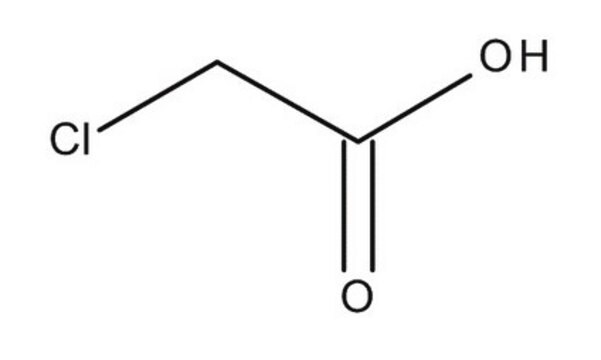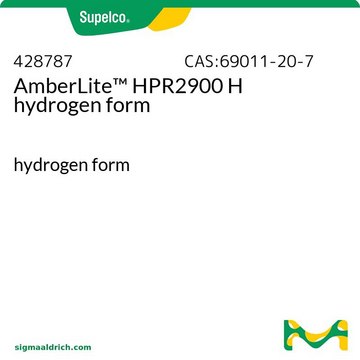Kluczowe dokumenty
36544
Chloroacetic acid
PESTANAL®, analytical standard
Synonim(y):
Monochloroacetic acid
About This Item
Polecane produkty
klasa czystości
analytical standard
Poziom jakości
gęstość pary
3.26 (vs air)
ciśnienie pary
0.75 mmHg ( 20 °C)
linia produktu
PESTANAL®
Próba
98-100% (HPLC)
okres trwałości
limited shelf life, expiry date on the label
metody
HPLC: suitable
gas chromatography (GC): suitable
bp
189 °C (lit.)
mp
60-63 °C (lit.)
Zastosowanie
agriculture
environmental
Format
neat
ciąg SMILES
OC(=O)CCl
InChI
1S/C2H3ClO2/c3-1-2(4)5/h1H2,(H,4,5)
Klucz InChI
FOCAUTSVDIKZOP-UHFFFAOYSA-N
Szukasz podobnych produktów? Odwiedź Przewodnik dotyczący porównywania produktów
Opis ogólny
Zastosowanie
- Natural waters by ion chromatography-electrospray ionization-tandem mass spectrometry (IC-ESI-MS/MS).
- Bottled water, swimming pool water, and both source water and drinking water from a drinking water facility by high performance IC-ESI-MS/MS with multiple reaction monitoring (MRM) detection.
- Tap water by gas chromatography-mass spectrometry (GC-MS).
- Drinking water by GC coupled to halogen-specific detector equipped with MS operating under the electron ionization mode.
Informacje prawne
Oświadczenie o zrzeczeniu się odpowiedzialności
Hasło ostrzegawcze
Danger
Zwroty wskazujące rodzaj zagrożenia
Zwroty wskazujące środki ostrożności
Klasyfikacja zagrożeń
Acute Tox. 3 Dermal - Acute Tox. 3 Inhalation - Acute Tox. 3 Oral - Aquatic Acute 1 - Eye Dam. 1 - Skin Corr. 1B - STOT SE 3
Organy docelowe
Respiratory system
Kod klasy składowania
6.1A - Combustible acute toxic Cat. 1 and 2 / very toxic hazardous materials
Klasa zagrożenia wodnego (WGK)
WGK 3
Temperatura zapłonu (°F)
258.8 °F - closed cup
Temperatura zapłonu (°C)
126 °C - closed cup
Środki ochrony indywidualnej
dust mask type N95 (US), Eyeshields, Faceshields, Gloves, type P2 (EN 143) respirator cartridges, type P3 (EN 143) respirator cartridges
Wybierz jedną z najnowszych wersji:
Masz już ten produkt?
Dokumenty związane z niedawno zakupionymi produktami zostały zamieszczone w Bibliotece dokumentów.
Nasz zespół naukowców ma doświadczenie we wszystkich obszarach badań, w tym w naukach przyrodniczych, materiałoznawstwie, syntezie chemicznej, chromatografii, analityce i wielu innych dziedzinach.
Skontaktuj się z zespołem ds. pomocy technicznej









